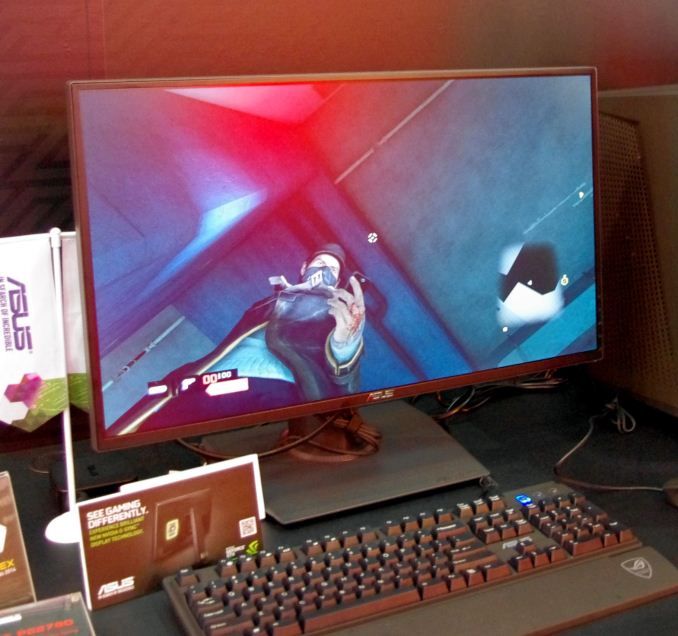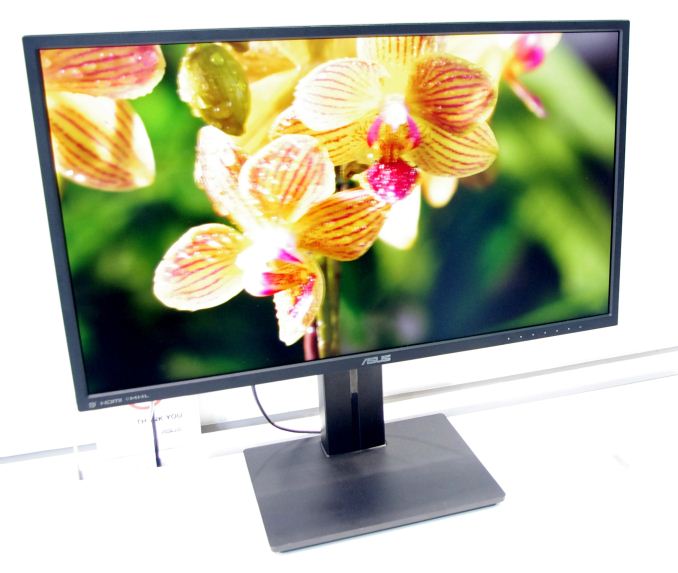Computex 2014: The ASUS Booth Tour
by Ian Cutress on June 11, 2014 11:45 AM ESTMonitors
Last year was the advent of some decent 4K UHD panels, especially with a nod towards more affordable models. Fast forward twelve months and 28-inch 3840x2160 monitors are hitting price points south of $1000 and penetrating more of the enthusiast monitor market, as well as the prosumer market. Add in to this the element of frame-rate synchronization technologies and we are in a very different place than we were at Computex 2013. To this end, ASUS had several of their newest monitors on show.
ROG Swift PG278Q
The PG278Q is a 27-inch 2560x1440p gaming monitor with G-Sync installed. The key element here is a narrow bezel as well as a quick-change button to switch between different refresh rates (60/120/144 Hz). The monitor uses DisplayPort, and also can act as a USB 3.0 hub (two downstream, one upstream).
The monitor can also do 3D (limited to 120 Hz), and is VESA wall mount compatible. The OSD is controlled by a small stick on the side of the panel
PB279Q
ASUS recently released the PB279Q, the 4K panel to challenge the likes of the Samsung U28D590 and Dell P2815Q but in the 27 inch form factor. The panel supports 3840x2160 at 60 Hz via DisplayPort on a single panel in the OS, meaning that no MST is taking place. The 163 ppi screen is also 100% sRGB and supports picture-in-picture with picture-by-picture up to four screens via the four HDMI/MHL inputs.
The panel also uses two speakers, with a fully adjustable tilt/swivel and pivot/height stand.
PA328Q
Moving up to the 32-inch segment, the PB328Q was also on display. With a bigger display we expect more functionality, and the USB 3.0 hub was clear to see:
The PA328Q moves down to 138ppi from the 27-inch 4K/UHD model, but still contains four HDMI/MHL inputs, picture-in-picture, picture-by-picture and 10-bit display.
Curved 32-inch Monitor
This product does not have a name yet, but it was quite striking against the other monitors present at the booth. The stand itself looks novel, and at a quick glance the curve was not wholly obvious but it is there:
The only feature points we know about it so far is the 2560x1440 resolution, 250 cd/m2 brightness and that it uses DisplayPort.
Designo MX27A
The latest update to the Designo range is this gold thin-bezeled number, using a 27” 2560x1440p panel via HDMI:
I’ll take three.
















23 Comments
View All Comments
457R4LDR34DKN07 - Wednesday, June 11, 2014 - link
Are you sure the MPCIE combo IV is PCIE 3.0? JJ from ASUS told me it was PCIE 2.0.Ian Cutress - Wednesday, June 11, 2014 - link
I'm double checking for you. I was under the impression that it was only PCIe 2.0 by virtue of a lack of PCIe 3.0 drives but still PCIe 3.0 capable due to CPU lanes rather than PCH lanes. I'm sure I asked this question during my tour; I either remembered what I hoped, or what I heard, given the whirlwind of meetings that week. I'll update when I get an answer back.Ian Cutress - Wednesday, June 11, 2014 - link
I got a response: PCIe version not yet confirmed. Device is due out Q3, and they have time to choose either way. If you have a preference, note it here: I'm sure ASUS will be looking.PCIe 3.0 x4 will reduce the main GPU slot to PCIe 3.0 x8, but in my testing at 1080p gaming, frame rates drop less than 1%.
PCIe 2.0 x4 will give a full 16 lanes to the GPU, but might restrict some of the lane allocations for extra functionality. This effect is lessened by using a mITX board because there is less space for the extra functionality so the designers are restricted in what they can do.
457R4LDR34DKN07 - Wednesday, June 11, 2014 - link
I don't have a preference as I have a z77 and not compelled to upgrade until broadwell or beyond. If I was ASUS I would stick to PCIE 2.0 because: A) No current M.2 drives with gen3 B) PCIE 16X 3.0 might be more important in future video cards and is a more likely upgrade for a gaming motherboard.k4z3t5ub4k1 - Wednesday, June 11, 2014 - link
Awesome, thanks for taking the time to ask. IMO, on the Mini-ITX boards, I am hoping that the combo card is 4x PCIe 3.0 from the CPU. Since the Mobo only has one PCIe slot for graphics, thus SLI or Crossfire is not even an option, PCIe 8x is more than enough so satisfy the requirement of even a top end GPU. I would rather lose the 1% FPS going from 16x to 8x and gain the added storage speed that can be brought with M.2 over 4x PCIe 3.0.Freakie - Wednesday, June 11, 2014 - link
I would vote for PCIe 3.0. Waiting for drives to catch up is better than waiting for drives to be the ones that start. The faster the rest of the ecosystem is ready for a new technology, the faster we get the new technology. It would be nice if they could implement a BIOS feature to switch it from 2.0 to 3.0 (not sure if that is even possible) so that way we have the flexibility to upgrade in the future, or customize our current setup by deciding if we want to give the mPCIe device 3.0 bandwidth and sacrifice slight GPU performance, or give the device 2.0 bandwidth and keep the performance.In the end, I think SSD's need more attention than GPU's right now.
dgingeri - Wednesday, June 11, 2014 - link
I saw my MB up there in the Server section. The Z97-WS is a really nice board, but I have already had trouble with it. The DIMM slots 3 and 4 died on me after 10 days.I understand that issues like this do come up once in a while. (I'm the admin of a server software test lab. As reliable as server hardware is, I still have about a quarter of my time taken up replacing defective parts.) Still, Asus's support system is a bit lacking when things do go bad. I started this ticket last Thursday, and they still haven't shipped my replacement board. The hoops I had to jump through took me until yesterday to get done, and they say they'll ship it within 48 hours. It looks like I probably won't have a replacement in time for the weekend. This has discouraged me from buying any of their server line for my employer. It just takes too long to get things swapped, specifically because their support system is flawed.
extide - Wednesday, June 11, 2014 - link
If both slots on a single channel no longer work you may want to try removing and re-inserting the CPU... Sometimes you can have issues like that.dgingeri - Wednesday, June 11, 2014 - link
yeah, tried that. no luck. There are a couple solder points on the back of the board at the DIMM slots that look suspect, though. That's why I went for the RMA.martixy - Wednesday, June 11, 2014 - link
I've been waiting for precisely this article.Light on the details, but in any case at least we have an update on upcoming release dates, be it from here or other coverage of Computex.